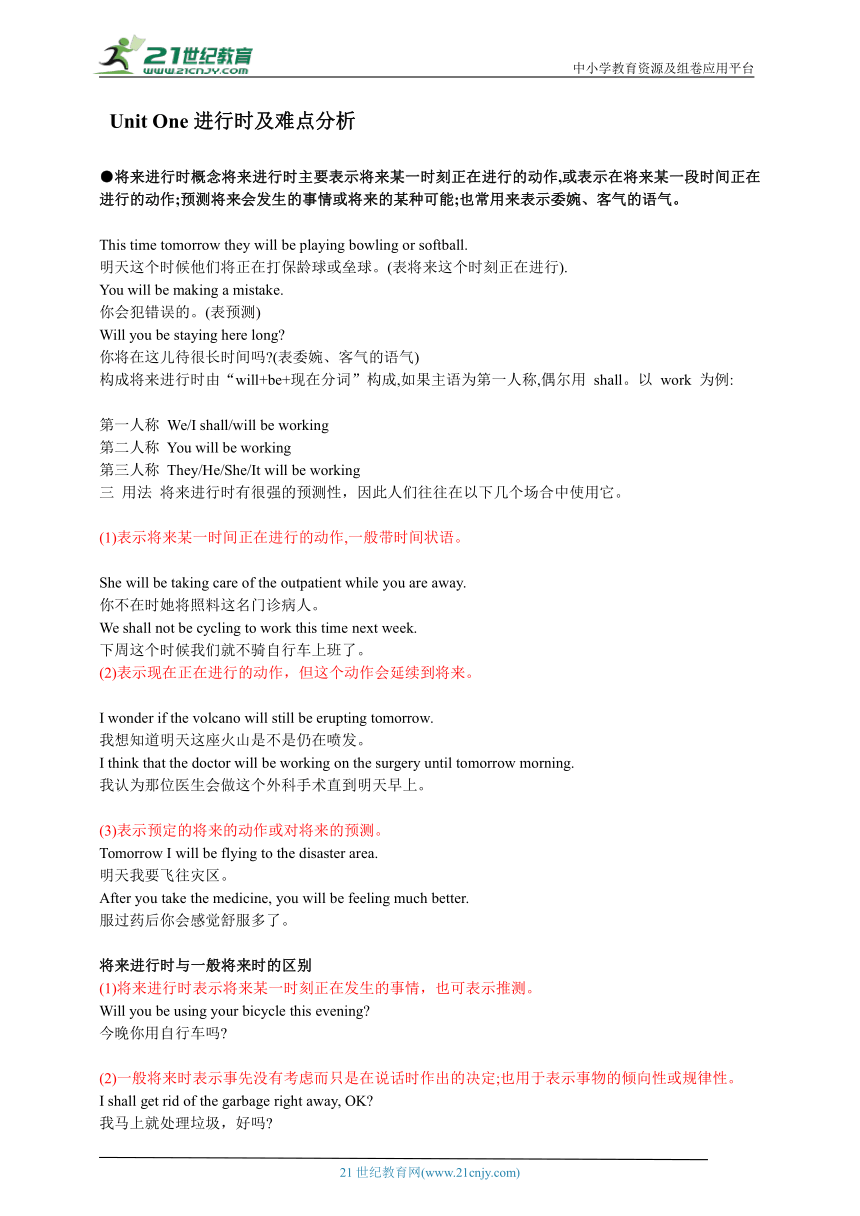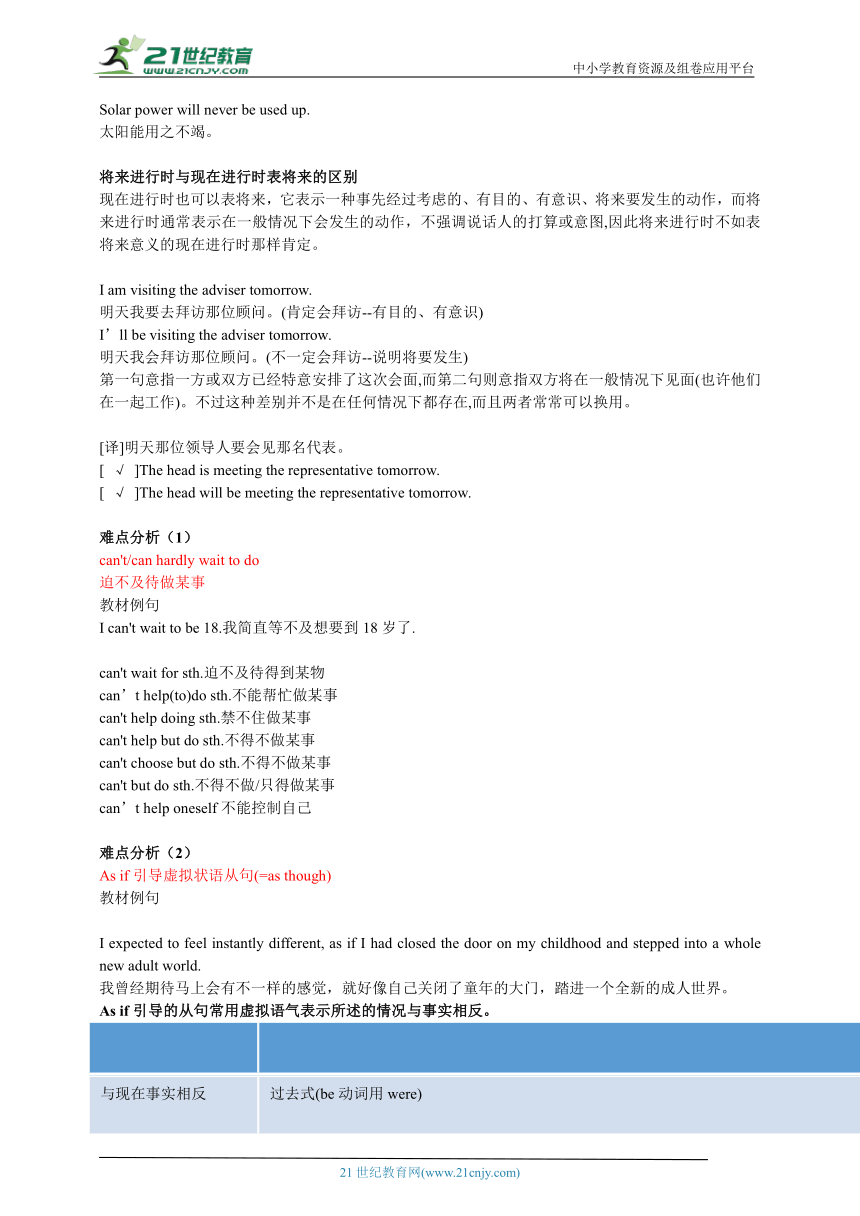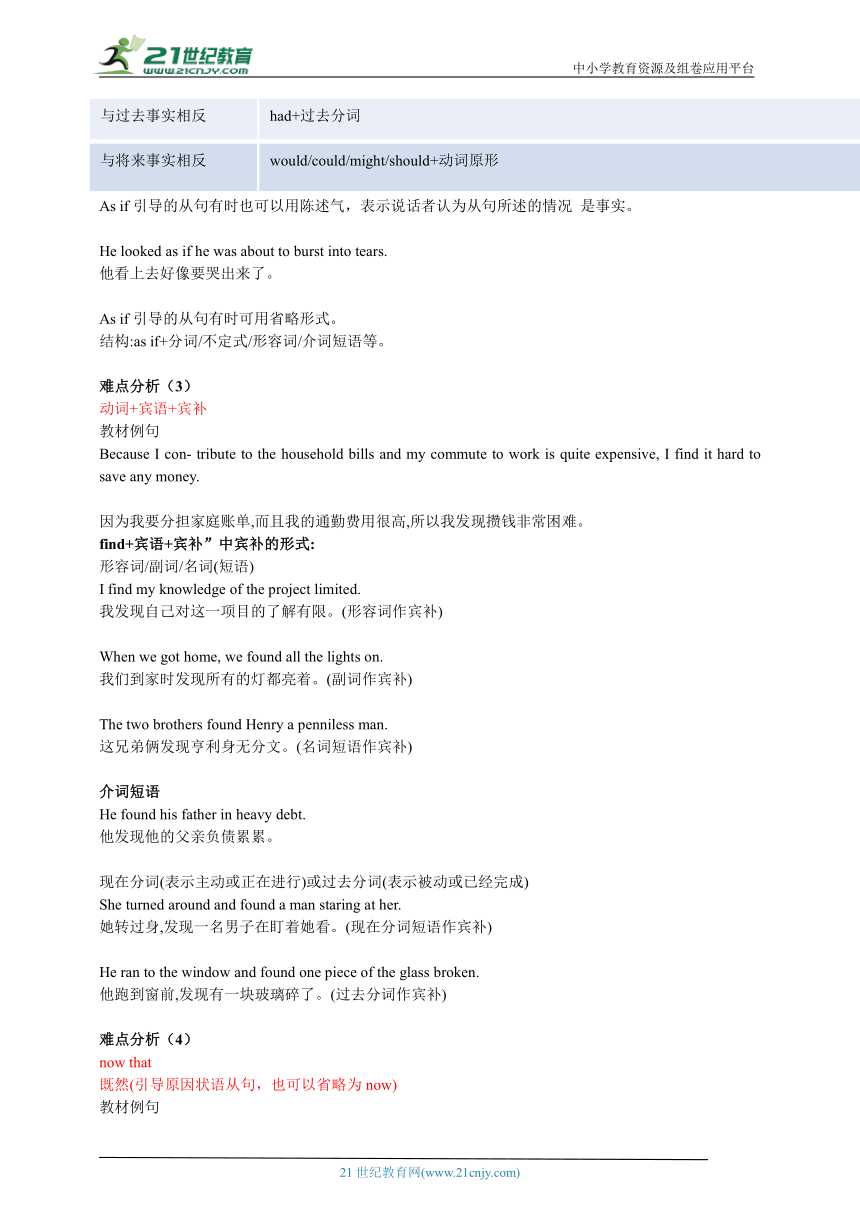(2019外研版)选修二Unit 1 Growing up讲义(精讲)
文档属性
| 名称 | (2019外研版)选修二Unit 1 Growing up讲义(精讲) |  | |
| 格式 | doc | ||
| 文件大小 | 280.4KB | ||
| 资源类型 | 试卷 | ||
| 版本资源 | 外研版(2019) | ||
| 科目 | 英语 | ||
| 更新时间 | 2024-05-06 18:56:49 | ||
图片预览



文档简介
中小学教育资源及组卷应用平台
Unit One进行时及难点分析
●将来进行时概念将来进行时主要表示将来某一时刻正在进行的动作,或表示在将来某一段时间正在进行的动作;预测将来会发生的事情或将来的某种可能;也常用来表示委婉、客气的语气。
This time tomorrow they will be playing bowling or softball.
明天这个时候他们将正在打保龄球或垒球。(表将来这个时刻正在进行).
You will be making a mistake.
你会犯错误的。(表预测)
Will you be staying here long
你将在这儿待很长时间吗 (表委婉、客气的语气)
构成将来进行时由“will+be+现在分词”构成,如果主语为第一人称,偶尔用 shall。以 work 为例:
第一人称 We/I shall/will be working
第二人称 You will be working
第三人称 They/He/She/It will be working
三 用法 将来进行时有很强的预测性,因此人们往往在以下几个场合中使用它。
(1)表示将来某一时间正在进行的动作,一般带时间状语。
She will be taking care of the outpatient while you are away.
你不在时她将照料这名门诊病人。
We shall not be cycling to work this time next week.
下周这个时候我们就不骑自行车上班了。
(2)表示现在正在进行的动作,但这个动作会延续到将来。
I wonder if the volcano will still be erupting tomorrow.
我想知道明天这座火山是不是仍在喷发。
I think that the doctor will be working on the surgery until tomorrow morning.
我认为那位医生会做这个外科手术直到明天早上。
(3)表示预定的将来的动作或对将来的预测。
Tomorrow I will be flying to the disaster area.
明天我要飞往灾区。
After you take the medicine, you will be feeling much better.
服过药后你会感觉舒服多了。
将来进行时与一般将来时的区别
(1)将来进行时表示将来某一时刻正在发生的事情,也可表示推测。
Will you be using your bicycle this evening
今晚你用自行车吗
(2)一般将来时表示事先没有考虑而只是在说话时作出的决定;也用于表示事物的倾向性或规律性。
I shall get rid of the garbage right away, OK
我马上就处理垃圾,好吗
Solar power will never be used up.
太阳能用之不竭。
将来进行时与现在进行时表将来的区别
现在进行时也可以表将来,它表示一种事先经过考虑的、有目的、有意识、将来要发生的动作,而将来进行时通常表示在一般情况下会发生的动作,不强调说话人的打算或意图,因此将来进行时不如表将来意义的现在进行时那样肯定。
I am visiting the adviser tomorrow.
明天我要去拜访那位顾问。(肯定会拜访--有目的、有意识)
I’ll be visiting the adviser tomorrow.
明天我会拜访那位顾问。(不一定会拜访--说明将要发生)
第一句意指一方或双方已经特意安排了这次会面,而第二句则意指双方将在一般情况下见面(也许他们在一起工作)。不过这种差别并不是在任何情况下都存在,而且两者常常可以换用。
[译]明天那位领导人要会见那名代表。
[ √ ]The head is meeting the representative tomorrow.
[ √ ]The head will be meeting the representative tomorrow.
难点分析(1)
can't/can hardly wait to do
迫不及待做某事
教材例句
I can't wait to be 18.我简直等不及想要到18岁了.
can't wait for sth.迫不及待得到某物
can’t help(to)do sth.不能帮忙做某事
can't help doing sth.禁不住做某事
can't help but do sth.不得不做某事
can't choose but do sth.不得不做某事
can't but do sth.不得不做/只得做某事
can’t help oneself不能控制自己
难点分析(2)
As if引导虚拟状语从句(=as though)
教材例句
I expected to feel instantly different, as if I had closed the door on my childhood and stepped into a whole new adult world.
我曾经期待马上会有不一样的感觉,就好像自己关闭了童年的大门,踏进一个全新的成人世界。
As if引导的从句常用虚拟语气表示所述的情况与事实相反。
与现在事实相反 过去式(be动词用were)
与过去事实相反 had+过去分词
与将来事实相反 would/could/might/should+动词原形
As if引导的从句有时也可以用陈述气,表示说话者认为从句所述的情况 是事实。
He looked as if he was about to burst into tears.
他看上去好像要哭出来了。
As if引导的从句有时可用省略形式。
结构:as if+分词/不定式/形容词/介词短语等。
难点分析(3)
动词+宾语+宾补
教材例句
Because I con- tribute to the household bills and my commute to work is quite expensive, I find it hard to save any money.
因为我要分担家庭账单,而且我的通勤费用很高,所以我发现攒钱非常困难。
find+宾语+宾补”中宾补的形式:
形容词/副词/名词(短语)
I find my knowledge of the project limited.
我发现自己对这一项目的了解有限。(形容词作宾补)
When we got home, we found all the lights on.
我们到家时发现所有的灯都亮着。(副词作宾补)
The two brothers found Henry a penniless man.
这兄弟俩发现亨利身无分文。(名词短语作宾补)
介词短语
He found his father in heavy debt.
他发现他的父亲负债累累。
现在分词(表示主动或正在进行)或过去分词(表示被动或已经完成)
She turned around and found a man staring at her.
她转过身,发现一名男子在盯着她看。(现在分词短语作宾补)
He ran to the window and found one piece of the glass broken.
他跑到窗前,发现有一块玻璃碎了。(过去分词作宾补)
难点分析(4)
now that
既然(引导原因状语从句,也可以省略为now)
教材例句
You asked if I have been thinking a lot about the future now that Im17.
你问我既然17岁了,是否一直对未来思考很多。
now that 相当于 since,引导原因状语从句,在口语中that可以省去,now仍表示“既然”。
如同although/though 不与but连用, because不与so连用一样,当since, now that引导的从句表原因时,主句前不能加 so。
既然你已准备好了,那我们现在就出发吧。
Now that you are ready, so we set off now.(x)
Now that you are ready, we set off now.(√)
常见的引导原因状语从句的从属连词有:
because,since,as, considering(that)等。
难点分析(6)
it's likely that...很可能
教材例句
As students, it's likely that those moments are mainly about school life, such as sitting a major exam, giving a presentation,or becoming a boarder for the first time.
作为学生,那些时刻很可能主要与学校生活有关,比如参加一场重要考试、做一次演讲或第一次成为寄宿生。
本句中it 为形式主语,代替that引导的主语从句,为it+be+adj.+that的典型句式.
that 在从句中仅起连接作用,不作句子成分,也无实际意义。
此结构是为了保持句子平衡而将真正的主语移到后面,这样做可以避免句子结构头重脚轻。
常见的it+be+adj.+that句式:
it+be+important/strange/surprising/natural/necessary
urgent/impossible..+ that...
it作形式主语,that引导真正的主语从句的句式还有:
It+be+done+that…。
如:
It is reported that... 据报道……
It is said that... 据说……
It is known to all that... 众所周知……
It's suggested that...有人建议……
It's believed that... 人们相信……
It's calculated that... 据计算……
It's acknowledged/accepted that... 众 所周知……
It‘s guessed/assessed that... 据估计……
难点分析(7)
“介词+关系代词”引导定语从句
教材例句
In1944, Saint-Exupéry left on a wartime mission over
occupied France,from which he never returned.
1944年,圣埃克苏佩里离开,前往被占领的法国执行战时任务,从此再也没回来。
使用“介词+关系代词”引导定语从句时需注意以下几点:
在“介词+关系代词”结构中,关系代词只用whom(先行词指人) which(先行词指物)和whose(表示所属关系)。
“介词+关系代词”可引导限制性定语从句和非限制性定语从句。
在限制性定语从句中,介词放在关系代词之前时,关系代词不能省略;但若介词后置,则可用that/who代替which/ whom,也可省略关系代词。
介词的确定要遵循“一先、二动、三意义”的原则。
“一先”即根据先行词的某种习惯搭配来确定介词;
“二动”即根据定语从句中动词或形容词所需要的某种习惯搭配来确定介词;
“三意义”即根据定语从句的意义来确定介词。
难点分析(8)
have sth. done使某事被做
教材例句
They always need to have things explained.
所有事情都非要你跟他们解释清楚他们才能懂。
have sth.done结构中,done作宾补。
表示使某事被做(可能主语自己做,也可能让别人做)、主语遭受或经历某种不幸的事情、请人做某事。
have sb. doing sth.
(1)can’t/won’t/couldn't have sb.doing sth.
表示“不能容忍某人做某事”。
(2)have sb.doing sth.
表示“让某人一直做某事”。
have sb.do sth.=let/make sb. do sth=get sb.to do sth.
让某人做某事
sb.与do之间为主动关系,do作宾补
have sth.to do有某事要做
(have是实义动词“有”,to do作后置定语)
难点分析(9)
强调句式
教材例句
It's the time you spent on your rose that makes your rose so important.
是你投入在玫瑰上的时间让你的玫瑰变得如此重要。
强调句型的基本结构是
“It is/was+被强调部分+that+其他部分.”。
如果被强调部分指人,可用who代替that。
该句型可强调主语、宾语、状语等,但不能强调谓语(如要强调谓语需借助助动词 do)。
使用强调句型时需要注意以下三点:
强调句型中的it不能用其他词代替。·用is还是was要根据原句的时态而定:属于现在或将来时间范畴的所有时态用is;属于过去时间范畴的所有时态用was。
被强调部分指人时,可以用who代替that,其他情况一律用that。
It is my father that/who will have a face-to-face talk with me.
是父亲要和我进行一次面对面的交谈。
判断句子是否为强调句型的方法:
去掉 it is/was 与 that/who,剩余部分若结构完整、句意明确,则为强调句型,否则就不是。
My grandpa walked the dog in the street yesterday.
昨天我爷爷在街上遛狗了。
→ It was my grandpa that/who walked the dog in the street yesterday.
(强调主语)
→ It was yesterday that my grandpa walked the dog in the street.
(强调时间状语)
→ It was in the street that my grandpa walked the dog yesterday.
(强调地点状语)
本单元词组
1.have a say 有发言权
2.no doubt 无疑地
3.ponder over 深思/考虑……
4.at a glance 一瞥,看一眼
5.close at hand 就在眼前;在附近
6.behind the wheel 在驾驶汽车
7.tempt sb.to do sth.引诱某人做某事
8.lay aside 把……搁置一边
9.distinguish...from... 把……与……区分开来
10.be pleased to do 很高兴做……
11.take responsibility for 为……负责
12.in the act of 正在做……时
14.devote oneself to 致力于,献身于
15. be concerned with 关心;涉及
16.keep one’s head 保持冷静;保持镇定(=keep calm)
17.make allowance(s) for 体谅;考虑到
18.in charge of 主管;负责
19.ever since 自从;从...以后
20.(be )based on 以...为基础或根据
21.(be) related to 与...有关联
22. in the long term =(in the long run) 从长远来看
23.be presented with 面对...;被授予;得到
24.stick at 坚持;坚持不懈地做
25.be obsessed with 对...着迷;困扰于...
26.in the act of 正在....;正在做...的过程中
27.care about 担心;关心;在乎
28.refer to 提到;谈到;参考;查阅;涉及;关于
21世纪教育网 www.21cnjy.com 精品试卷·第 2 页 (共 2 页)
21世纪教育网(www.21cnjy.com)
Unit One进行时及难点分析
●将来进行时概念将来进行时主要表示将来某一时刻正在进行的动作,或表示在将来某一段时间正在进行的动作;预测将来会发生的事情或将来的某种可能;也常用来表示委婉、客气的语气。
This time tomorrow they will be playing bowling or softball.
明天这个时候他们将正在打保龄球或垒球。(表将来这个时刻正在进行).
You will be making a mistake.
你会犯错误的。(表预测)
Will you be staying here long
你将在这儿待很长时间吗 (表委婉、客气的语气)
构成将来进行时由“will+be+现在分词”构成,如果主语为第一人称,偶尔用 shall。以 work 为例:
第一人称 We/I shall/will be working
第二人称 You will be working
第三人称 They/He/She/It will be working
三 用法 将来进行时有很强的预测性,因此人们往往在以下几个场合中使用它。
(1)表示将来某一时间正在进行的动作,一般带时间状语。
She will be taking care of the outpatient while you are away.
你不在时她将照料这名门诊病人。
We shall not be cycling to work this time next week.
下周这个时候我们就不骑自行车上班了。
(2)表示现在正在进行的动作,但这个动作会延续到将来。
I wonder if the volcano will still be erupting tomorrow.
我想知道明天这座火山是不是仍在喷发。
I think that the doctor will be working on the surgery until tomorrow morning.
我认为那位医生会做这个外科手术直到明天早上。
(3)表示预定的将来的动作或对将来的预测。
Tomorrow I will be flying to the disaster area.
明天我要飞往灾区。
After you take the medicine, you will be feeling much better.
服过药后你会感觉舒服多了。
将来进行时与一般将来时的区别
(1)将来进行时表示将来某一时刻正在发生的事情,也可表示推测。
Will you be using your bicycle this evening
今晚你用自行车吗
(2)一般将来时表示事先没有考虑而只是在说话时作出的决定;也用于表示事物的倾向性或规律性。
I shall get rid of the garbage right away, OK
我马上就处理垃圾,好吗
Solar power will never be used up.
太阳能用之不竭。
将来进行时与现在进行时表将来的区别
现在进行时也可以表将来,它表示一种事先经过考虑的、有目的、有意识、将来要发生的动作,而将来进行时通常表示在一般情况下会发生的动作,不强调说话人的打算或意图,因此将来进行时不如表将来意义的现在进行时那样肯定。
I am visiting the adviser tomorrow.
明天我要去拜访那位顾问。(肯定会拜访--有目的、有意识)
I’ll be visiting the adviser tomorrow.
明天我会拜访那位顾问。(不一定会拜访--说明将要发生)
第一句意指一方或双方已经特意安排了这次会面,而第二句则意指双方将在一般情况下见面(也许他们在一起工作)。不过这种差别并不是在任何情况下都存在,而且两者常常可以换用。
[译]明天那位领导人要会见那名代表。
[ √ ]The head is meeting the representative tomorrow.
[ √ ]The head will be meeting the representative tomorrow.
难点分析(1)
can't/can hardly wait to do
迫不及待做某事
教材例句
I can't wait to be 18.我简直等不及想要到18岁了.
can't wait for sth.迫不及待得到某物
can’t help(to)do sth.不能帮忙做某事
can't help doing sth.禁不住做某事
can't help but do sth.不得不做某事
can't choose but do sth.不得不做某事
can't but do sth.不得不做/只得做某事
can’t help oneself不能控制自己
难点分析(2)
As if引导虚拟状语从句(=as though)
教材例句
I expected to feel instantly different, as if I had closed the door on my childhood and stepped into a whole new adult world.
我曾经期待马上会有不一样的感觉,就好像自己关闭了童年的大门,踏进一个全新的成人世界。
As if引导的从句常用虚拟语气表示所述的情况与事实相反。
与现在事实相反 过去式(be动词用were)
与过去事实相反 had+过去分词
与将来事实相反 would/could/might/should+动词原形
As if引导的从句有时也可以用陈述气,表示说话者认为从句所述的情况 是事实。
He looked as if he was about to burst into tears.
他看上去好像要哭出来了。
As if引导的从句有时可用省略形式。
结构:as if+分词/不定式/形容词/介词短语等。
难点分析(3)
动词+宾语+宾补
教材例句
Because I con- tribute to the household bills and my commute to work is quite expensive, I find it hard to save any money.
因为我要分担家庭账单,而且我的通勤费用很高,所以我发现攒钱非常困难。
find+宾语+宾补”中宾补的形式:
形容词/副词/名词(短语)
I find my knowledge of the project limited.
我发现自己对这一项目的了解有限。(形容词作宾补)
When we got home, we found all the lights on.
我们到家时发现所有的灯都亮着。(副词作宾补)
The two brothers found Henry a penniless man.
这兄弟俩发现亨利身无分文。(名词短语作宾补)
介词短语
He found his father in heavy debt.
他发现他的父亲负债累累。
现在分词(表示主动或正在进行)或过去分词(表示被动或已经完成)
She turned around and found a man staring at her.
她转过身,发现一名男子在盯着她看。(现在分词短语作宾补)
He ran to the window and found one piece of the glass broken.
他跑到窗前,发现有一块玻璃碎了。(过去分词作宾补)
难点分析(4)
now that
既然(引导原因状语从句,也可以省略为now)
教材例句
You asked if I have been thinking a lot about the future now that Im17.
你问我既然17岁了,是否一直对未来思考很多。
now that 相当于 since,引导原因状语从句,在口语中that可以省去,now仍表示“既然”。
如同although/though 不与but连用, because不与so连用一样,当since, now that引导的从句表原因时,主句前不能加 so。
既然你已准备好了,那我们现在就出发吧。
Now that you are ready, so we set off now.(x)
Now that you are ready, we set off now.(√)
常见的引导原因状语从句的从属连词有:
because,since,as, considering(that)等。
难点分析(6)
it's likely that...很可能
教材例句
As students, it's likely that those moments are mainly about school life, such as sitting a major exam, giving a presentation,or becoming a boarder for the first time.
作为学生,那些时刻很可能主要与学校生活有关,比如参加一场重要考试、做一次演讲或第一次成为寄宿生。
本句中it 为形式主语,代替that引导的主语从句,为it+be+adj.+that的典型句式.
that 在从句中仅起连接作用,不作句子成分,也无实际意义。
此结构是为了保持句子平衡而将真正的主语移到后面,这样做可以避免句子结构头重脚轻。
常见的it+be+adj.+that句式:
it+be+important/strange/surprising/natural/necessary
urgent/impossible..+ that...
it作形式主语,that引导真正的主语从句的句式还有:
It+be+done+that…。
如:
It is reported that... 据报道……
It is said that... 据说……
It is known to all that... 众所周知……
It's suggested that...有人建议……
It's believed that... 人们相信……
It's calculated that... 据计算……
It's acknowledged/accepted that... 众 所周知……
It‘s guessed/assessed that... 据估计……
难点分析(7)
“介词+关系代词”引导定语从句
教材例句
In1944, Saint-Exupéry left on a wartime mission over
occupied France,from which he never returned.
1944年,圣埃克苏佩里离开,前往被占领的法国执行战时任务,从此再也没回来。
使用“介词+关系代词”引导定语从句时需注意以下几点:
在“介词+关系代词”结构中,关系代词只用whom(先行词指人) which(先行词指物)和whose(表示所属关系)。
“介词+关系代词”可引导限制性定语从句和非限制性定语从句。
在限制性定语从句中,介词放在关系代词之前时,关系代词不能省略;但若介词后置,则可用that/who代替which/ whom,也可省略关系代词。
介词的确定要遵循“一先、二动、三意义”的原则。
“一先”即根据先行词的某种习惯搭配来确定介词;
“二动”即根据定语从句中动词或形容词所需要的某种习惯搭配来确定介词;
“三意义”即根据定语从句的意义来确定介词。
难点分析(8)
have sth. done使某事被做
教材例句
They always need to have things explained.
所有事情都非要你跟他们解释清楚他们才能懂。
have sth.done结构中,done作宾补。
表示使某事被做(可能主语自己做,也可能让别人做)、主语遭受或经历某种不幸的事情、请人做某事。
have sb. doing sth.
(1)can’t/won’t/couldn't have sb.doing sth.
表示“不能容忍某人做某事”。
(2)have sb.doing sth.
表示“让某人一直做某事”。
have sb.do sth.=let/make sb. do sth=get sb.to do sth.
让某人做某事
sb.与do之间为主动关系,do作宾补
have sth.to do有某事要做
(have是实义动词“有”,to do作后置定语)
难点分析(9)
强调句式
教材例句
It's the time you spent on your rose that makes your rose so important.
是你投入在玫瑰上的时间让你的玫瑰变得如此重要。
强调句型的基本结构是
“It is/was+被强调部分+that+其他部分.”。
如果被强调部分指人,可用who代替that。
该句型可强调主语、宾语、状语等,但不能强调谓语(如要强调谓语需借助助动词 do)。
使用强调句型时需要注意以下三点:
强调句型中的it不能用其他词代替。·用is还是was要根据原句的时态而定:属于现在或将来时间范畴的所有时态用is;属于过去时间范畴的所有时态用was。
被强调部分指人时,可以用who代替that,其他情况一律用that。
It is my father that/who will have a face-to-face talk with me.
是父亲要和我进行一次面对面的交谈。
判断句子是否为强调句型的方法:
去掉 it is/was 与 that/who,剩余部分若结构完整、句意明确,则为强调句型,否则就不是。
My grandpa walked the dog in the street yesterday.
昨天我爷爷在街上遛狗了。
→ It was my grandpa that/who walked the dog in the street yesterday.
(强调主语)
→ It was yesterday that my grandpa walked the dog in the street.
(强调时间状语)
→ It was in the street that my grandpa walked the dog yesterday.
(强调地点状语)
本单元词组
1.have a say 有发言权
2.no doubt 无疑地
3.ponder over 深思/考虑……
4.at a glance 一瞥,看一眼
5.close at hand 就在眼前;在附近
6.behind the wheel 在驾驶汽车
7.tempt sb.to do sth.引诱某人做某事
8.lay aside 把……搁置一边
9.distinguish...from... 把……与……区分开来
10.be pleased to do 很高兴做……
11.take responsibility for 为……负责
12.in the act of 正在做……时
14.devote oneself to 致力于,献身于
15. be concerned with 关心;涉及
16.keep one’s head 保持冷静;保持镇定(=keep calm)
17.make allowance(s) for 体谅;考虑到
18.in charge of 主管;负责
19.ever since 自从;从...以后
20.(be )based on 以...为基础或根据
21.(be) related to 与...有关联
22. in the long term =(in the long run) 从长远来看
23.be presented with 面对...;被授予;得到
24.stick at 坚持;坚持不懈地做
25.be obsessed with 对...着迷;困扰于...
26.in the act of 正在....;正在做...的过程中
27.care about 担心;关心;在乎
28.refer to 提到;谈到;参考;查阅;涉及;关于
21世纪教育网 www.21cnjy.com 精品试卷·第 2 页 (共 2 页)
21世纪教育网(www.21cnjy.com)
